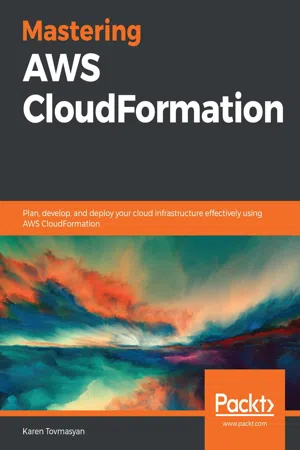
Mastering AWS CloudFormation
Plan, develop, and deploy your cloud infrastructure effectively using AWS CloudFormation
- 300 pages
- English
- ePUB (mobile friendly)
- Available on iOS & Android
Mastering AWS CloudFormation
Plan, develop, and deploy your cloud infrastructure effectively using AWS CloudFormation
About this book
Build scalable and production-ready infrastructure in Amazon Web Services with CloudFormation
Key Features
- Leverage AWS CloudFormation templates to manage your entire infrastructure
- Get up and running with writing your infrastructure as code and automating your environment
- Simplify infrastructure management and increase productivity with AWS CloudFormation
Book Description
DevOps and the cloud revolution have forced software engineers and operations teams to rethink how to manage infrastructures. With this AWS book, you'll understand how you can use Infrastructure as Code (IaC) to simplify IT operations and manage the modern cloud infrastructure effectively with AWS CloudFormation.This comprehensive guide will help you explore AWS CloudFormation from template structures through to developing complex and reusable infrastructure stacks. You'll then delve into validating templates, deploying stacks, and handling deployment failures. The book will also show you how to leverage AWS CodeBuild and CodePipeline to automate resource delivery and apply continuous integration and continuous delivery (CI/CD) practices to the stack. As you advance, you'll learn how to generate templates on the fly using macros and create resources outside AWS with custom resources. Finally, you'll improve the way you manage the modern cloud in AWS by extending CloudFormation using AWS serverless application model (SAM) and AWS cloud development kit (CDK).By the end of this book, you'll have mastered all the major AWS CloudFormation concepts and be able to simplify infrastructure management.
What you will learn
- Understand modern approaches to IaC
- Develop universal and reusable CloudFormation templates
- Discover ways to apply continuous delivery with CloudFormation
- Implement IaC best practices for the AWS Cloud
- Provision massive applications across multiple regions and accounts
- Automate template generation and software provisioning for AWS
- Extend CloudFormation with custom resources and template macros
Who this book is for
If you are a developer who wants to learn how to write templates, a DevOps engineer interested in deployment and orchestration, or a solutions architect looking to understand the benefits of managing infrastructure with ease, this book is for you. Prior understanding of the AWS Cloud is necessary.
]]>
Frequently asked questions
- Essential is ideal for learners and professionals who enjoy exploring a wide range of subjects. Access the Essential Library with 800,000+ trusted titles and best-sellers across business, personal growth, and the humanities. Includes unlimited reading time and Standard Read Aloud voice.
- Complete: Perfect for advanced learners and researchers needing full, unrestricted access. Unlock 1.4M+ books across hundreds of subjects, including academic and specialized titles. The Complete Plan also includes advanced features like Premium Read Aloud and Research Assistant.
Please note we cannot support devices running on iOS 13 and Android 7 or earlier. Learn more about using the app.
Information
Section 1: CloudFormation Internals
- Chapter 1, CloudFormation Refresher
- Chapter 2, Advanced Template Development
CloudFormation Refresher
- The internals of AWS CloudFormation
- Creating and updating a CloudFormation stack
- Managing permissions for CloudFormation
- Detecting unmanaged changes in our stack
Technical requirements
Understanding the internals of AWS CloudFormation
- API
- Backend
- Storage
Creating your first stack
Understanding CloudFormation IAM permissions
Table of contents
- Mastering AWS CloudFormation
- Why subscribe?
- Preface
- Section 1: CloudFormation Internals
- CloudFormation Refresher
- Advanced Template Development
- Section 2: Provisioning and Deployment at Scale
- Validation, Linting, and Deployment of the Stack
- Continuous Integration and Deployment
- Deploying to Multiple Regions and Accounts Using StackSets
- Configuration Management of the EC2 Instances Using cfn-init
- Section 3: Extending CloudFormation
- Creating Resources outside AWS Using Custom Resources
- Dynamically Rendering the Template Using Template Macros
- Generating CloudFormation Templates Using AWS CDK
- Deploying Serverless Applications Using AWS SAM
- What's Next?
- Assessments
- Other Books You May Enjoy